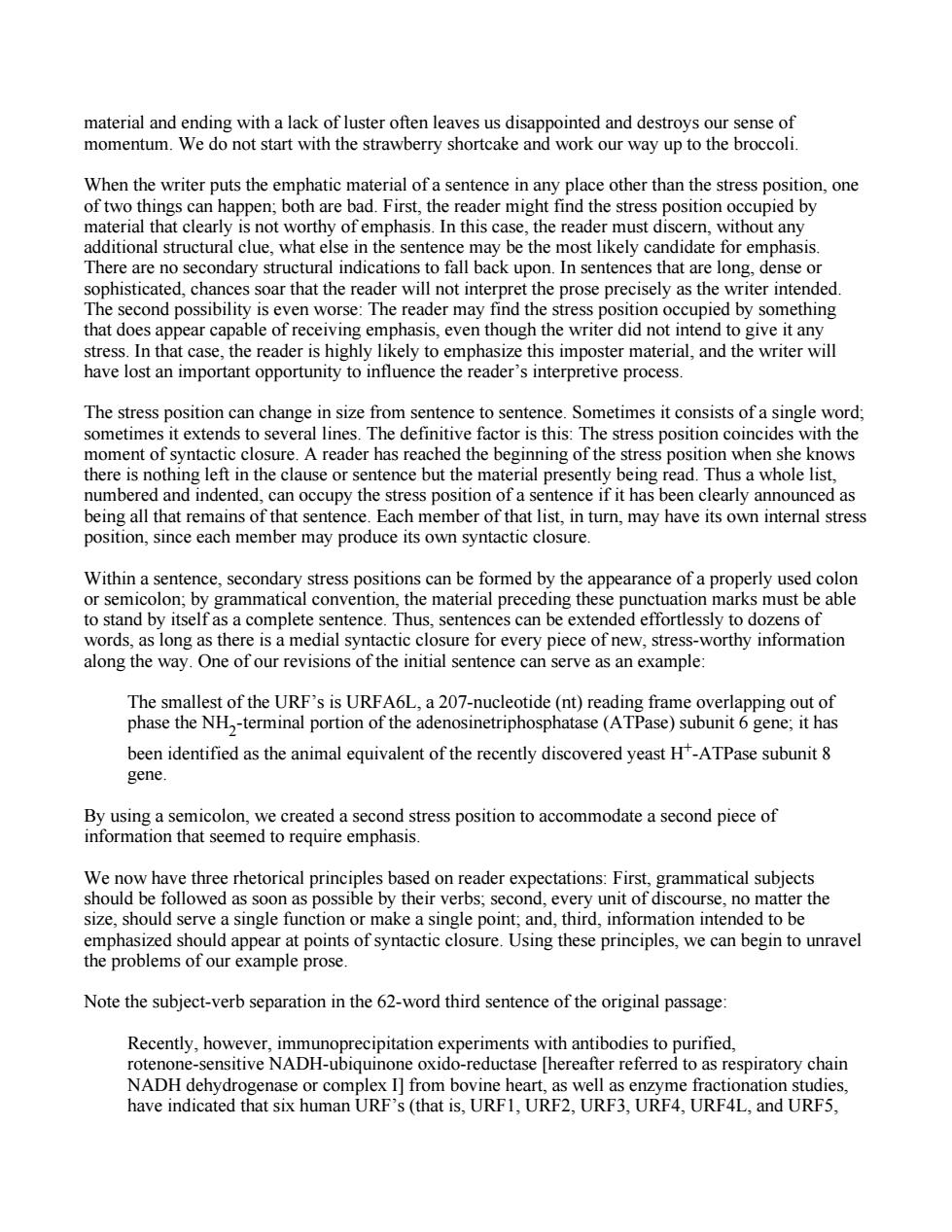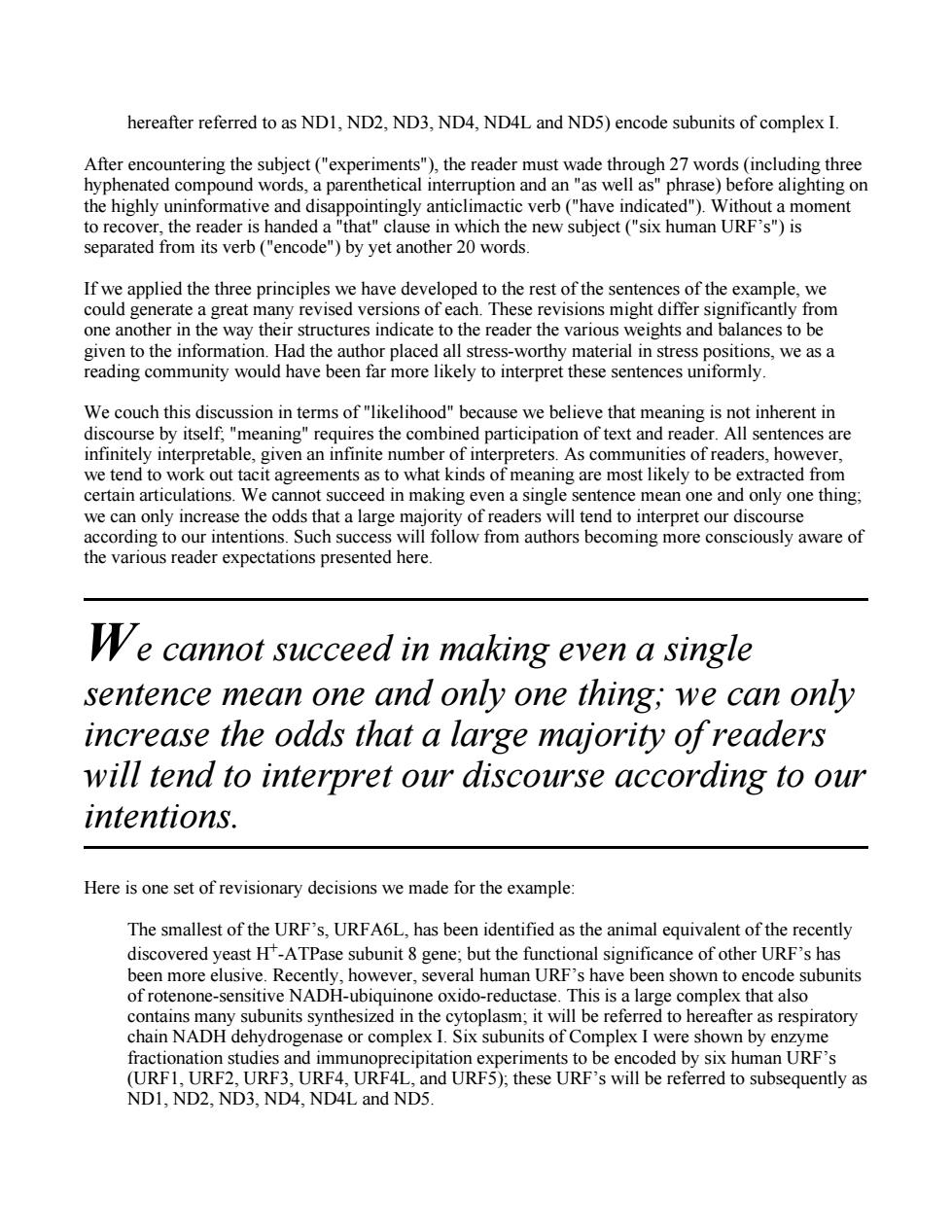
material and ending with a lack of luster often leaves us disappointed and destroys our sense of momentum.We do not start with the strawberry shortcake and work our way up to the broccoli. When the writer puts the emphatic material of a sentence in any place other than the stress position,one of two things can happen;both are bad.First,the reader might find the stress position occupied by material that clearly is not worthy of emphasis.In this case,the reader must discern,without any additional structural clue,what else in the sentence may be the most likely candidate for emphasis There are no secondary structural indications to fall back upon.In sentences that are long,dense or sophisticated,chances soar that the reader will not interpret the prose precisely as the writer intended. The second possibility is even worse:The reader may find the stress position occupied by something that does appear capable of receiving emphasis,even though the writer did not intend to give it any stress.In that case,the reader is highly likely to emphasize this imposter material,and the writer will have lost an important opportunity to influence the reader's interpretive process. The stress position can change in size from sentence to sentence.Sometimes it consists of a single word; sometimes it extends to several lines.The definitive factor is this:The stress position coincides with the moment of syntactic closure.A reader has reached the beginning of the stress position when she knows there is nothing left in the clause or sentence but the material presently being read.Thus a whole list, numbered and indented,can occupy the stress position of a sentence if it has been clearly announced as being all that remains of that sentence.Each member of that list,in turn,may have its own internal stress position,since each member may produce its own syntactic closure. Within a sentence,secondary stress positions can be formed by the appearance of a properly used colon or semicolon;by grammatical convention,the material preceding these punctuation marks must be able to stand by itself as a complete sentence.Thus,sentences can be extended effortlessly to dozens of words,as long as there is a medial syntactic closure for every piece of new,stress-worthy information along the way.One of our revisions of the initial sentence can serve as an example: The smallest of the URF's is URFA6L,a 207-nucleotide(nt)reading frame overlapping out of phase the NH-terminal portion of the adenosinetriphosphatase(ATPase)subunit 6 gene;it has been identified as the animal equivalent of the recently discovered yeast H-ATPase subunit 8 gene. By using a semicolon,we created a second stress position to accommodate a second piece of information that seemed to require emphasis. We now have three rhetorical principles based on reader expectations:First,grammatical subjects should be followed as soon as possible by their verbs;second,every unit of discourse,no matter the size,should serve a single function or make a single point;and,third,information intended to be emphasized should appear at points of syntactic closure.Using these principles,we can begin to unravel the problems of our example prose. Note the subject-verb separation in the 62-word third sentence of the original passage: Recently,however,immunoprecipitation experiments with antibodies to purified, rotenone-sensitive NADH-ubiquinone oxido-reductase [hereafter referred to as respiratory chain NADH dehydrogenase or complex I]from bovine heart,as well as enzyme fractionation studies, have indicated that six human URF's(that is,URF1,URF2,URF3,URF4,URF4L,and URF5
material and ending with a lack of luster often leaves us disappointed and destroys our sense of momentum. We do not start with the strawberry shortcake and work our way up to the broccoli. When the writer puts the emphatic material of a sentence in any place other than the stress position, one of two things can happen; both are bad. First, the reader might find the stress position occupied by material that clearly is not worthy of emphasis. In this case, the reader must discern, without any additional structural clue, what else in the sentence may be the most likely candidate for emphasis. There are no secondary structural indications to fall back upon. In sentences that are long, dense or sophisticated, chances soar that the reader will not interpret the prose precisely as the writer intended. The second possibility is even worse: The reader may find the stress position occupied by something that does appear capable of receiving emphasis, even though the writer did not intend to give it any stress. In that case, the reader is highly likely to emphasize this imposter material, and the writer will have lost an important opportunity to influence the reader’s interpretive process. The stress position can change in size from sentence to sentence. Sometimes it consists of a single word; sometimes it extends to several lines. The definitive factor is this: The stress position coincides with the moment of syntactic closure. A reader has reached the beginning of the stress position when she knows there is nothing left in the clause or sentence but the material presently being read. Thus a whole list, numbered and indented, can occupy the stress position of a sentence if it has been clearly announced as being all that remains of that sentence. Each member of that list, in turn, may have its own internal stress position, since each member may produce its own syntactic closure. Within a sentence, secondary stress positions can be formed by the appearance of a properly used colon or semicolon; by grammatical convention, the material preceding these punctuation marks must be able to stand by itself as a complete sentence. Thus, sentences can be extended effortlessly to dozens of words, as long as there is a medial syntactic closure for every piece of new, stress-worthy information along the way. One of our revisions of the initial sentence can serve as an example: The smallest of the URF’s is URFA6L, a 207-nucleotide (nt) reading frame overlapping out of phase the NH2 -terminal portion of the adenosinetriphosphatase (ATPase) subunit 6 gene; it has been identified as the animal equivalent of the recently discovered yeast H+ -ATPase subunit 8 gene. By using a semicolon, we created a second stress position to accommodate a second piece of information that seemed to require emphasis. We now have three rhetorical principles based on reader expectations: First, grammatical subjects should be followed as soon as possible by their verbs; second, every unit of discourse, no matter the size, should serve a single function or make a single point; and, third, information intended to be emphasized should appear at points of syntactic closure. Using these principles, we can begin to unravel the problems of our example prose. Note the subject-verb separation in the 62-word third sentence of the original passage: Recently, however, immunoprecipitation experiments with antibodies to purified, rotenone-sensitive NADH-ubiquinone oxido-reductase [hereafter referred to as respiratory chain NADH dehydrogenase or complex I] from bovine heart, as well as enzyme fractionation studies, have indicated that six human URF’s (that is, URF1, URF2, URF3, URF4, URF4L, and URF5

hereafter referred to as ND1,ND2,ND3,ND4,ND4L and ND5)encode subunits of complex I. After encountering the subject("experiments"),the reader must wade through 27 words(including three hyphenated compound words,a parenthetical interruption and an"as well as"phrase)before alighting on the highly uninformative and disappointingly anticlimactic verb("have indicated").Without a moment to recover,the reader is handed a "that"clause in which the new subject("six human URF's")is separated from its verb("encode")by yet another 20 words. If we applied the three principles we have developed to the rest of the sentences of the example,we could generate a great many revised versions of each.These revisions might differ significantly from one another in the way their structures indicate to the reader the various weights and balances to be given to the information.Had the author placed all stress-worthy material in stress positions,we as a reading community would have been far more likely to interpret these sentences uniformly. We couch this discussion in terms of "likelihood"because we believe that meaning is not inherent in discourse by itself;"meaning"requires the combined participation of text and reader.All sentences are infinitely interpretable,given an infinite number of interpreters.As communities of readers,however, we tend to work out tacit agreements as to what kinds of meaning are most likely to be extracted from certain articulations.We cannot succeed in making even a single sentence mean one and only one thing; we can only increase the odds that a large majority of readers will tend to interpret our discourse according to our intentions.Such success will follow from authors becoming more consciously aware of the various reader expectations presented here. We cannot succeed in making even a single sentence mean one and only one thing;we can only increase the odds that a large majority ofreaders will tend to interpret our discourse according to our intentions. Here is one set of revisionary decisions we made for the example: The smallest of the URF's,URFA6L,has been identified as the animal equivalent of the recently discovered yeast H-ATPase subunit 8 gene;but the functional significance of other URF's has been more elusive.Recently,however,several human URF's have been shown to encode subunits of rotenone-sensitive NADH-ubiquinone oxido-reductase.This is a large complex that also contains many subunits synthesized in the cytoplasm;it will be referred to hereafter as respiratory chain NADH dehydrogenase or complex I.Six subunits of Complex I were shown by enzyme fractionation studies and immunoprecipitation experiments to be encoded by six human URF's (URF1,URF2,URF3,URF4,URF4L,and URF5);these URF's will be referred to subsequently as ND1,ND2,ND3,ND4,ND4L and ND5
hereafter referred to as ND1, ND2, ND3, ND4, ND4L and ND5) encode subunits of complex I. After encountering the subject ("experiments"), the reader must wade through 27 words (including three hyphenated compound words, a parenthetical interruption and an "as well as" phrase) before alighting on the highly uninformative and disappointingly anticlimactic verb ("have indicated"). Without a moment to recover, the reader is handed a "that" clause in which the new subject ("six human URF’s") is separated from its verb ("encode") by yet another 20 words. If we applied the three principles we have developed to the rest of the sentences of the example, we could generate a great many revised versions of each. These revisions might differ significantly from one another in the way their structures indicate to the reader the various weights and balances to be given to the information. Had the author placed all stress-worthy material in stress positions, we as a reading community would have been far more likely to interpret these sentences uniformly. We couch this discussion in terms of "likelihood" because we believe that meaning is not inherent in discourse by itself; "meaning" requires the combined participation of text and reader. All sentences are infinitely interpretable, given an infinite number of interpreters. As communities of readers, however, we tend to work out tacit agreements as to what kinds of meaning are most likely to be extracted from certain articulations. We cannot succeed in making even a single sentence mean one and only one thing; we can only increase the odds that a large majority of readers will tend to interpret our discourse according to our intentions. Such success will follow from authors becoming more consciously aware of the various reader expectations presented here. We cannot succeed in making even a single sentence mean one and only one thing; we can only increase the odds that a large majority of readers will tend to interpret our discourse according to our intentions. Here is one set of revisionary decisions we made for the example: The smallest of the URF’s, URFA6L, has been identified as the animal equivalent of the recently discovered yeast H+ -ATPase subunit 8 gene; but the functional significance of other URF’s has been more elusive. Recently, however, several human URF’s have been shown to encode subunits of rotenone-sensitive NADH-ubiquinone oxido-reductase. This is a large complex that also contains many subunits synthesized in the cytoplasm; it will be referred to hereafter as respiratory chain NADH dehydrogenase or complex I. Six subunits of Complex I were shown by enzyme fractionation studies and immunoprecipitation experiments to be encoded by six human URF’s (URF1, URF2, URF3, URF4, URF4L, and URF5); these URF’s will be referred to subsequently as ND1, ND2, ND3, ND4, ND4L and ND5